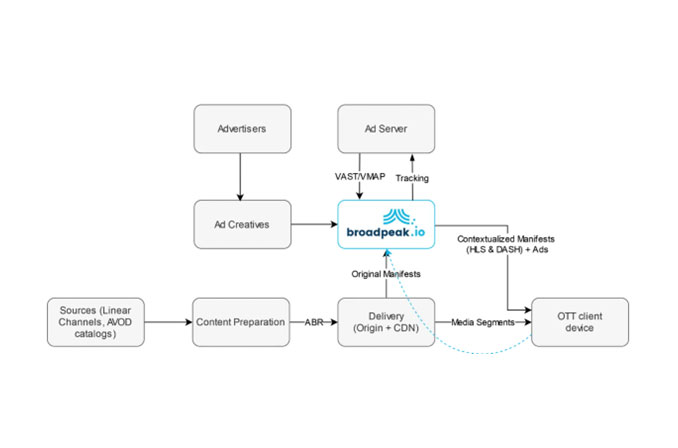OKAST and Broadpeak claim they are laying the technology foundations for what they call FAST 2.0 – characterised (by them) by faster deployment and wider distribution alongside higher channel performance and lower costs. This is achieved thanks to dynamic personalisation of channel content so it is more suited to individual tastes, and dynamic content replacement within the channel in order to meet business rules associated with the many different platforms and markets where a FAST channel is distributed. FAST distribution via Pay TV operator platforms (with streamlined delivery using an operator CDN) is another feature of ‘FAST 2.0’.
OKAST enables FAST creation and distribution via a modular cloud solution called OKAST Channels that includes programming, playout, transcoding, distribution, and advertising monetisation services. The company says it has deployed over 500 OTT platforms and FAST channels. Broadpeak provides video delivery components for content providers and network operators deploying video streaming services, including operator CDNs. The company’s advanced video API cloud platform, broadpeak.io, offers as-a-service solutions for dynamic ad insertion, linear virtual channel creation, and content personalisation. The companies are now integrating OKAST Channels and broadpeak.io.
The vendors say their partnership results in an advanced FAST offer that enables publishers to differentiate themselves in the market to achieve greater audience engagement. The technology helps content owners better monetise their inventory, the companies claim. The dynamic adaptation of channel content is key to success, and this is achieved thanks to Broadpeak’s Server-Side Ad Insertion (SSAI) solution (available on broadpeak.io SaaS) in combination with AI. The line-up of channels is customised to end user tastes.
The content line-up is also changed using dynamic programme replacement in order to meet the business rules associated with a diverse distribution marketplace. As the vendors explain, channel distribution to multiple connected TV platforms and applications, all with their own specific requirements, generates very high costs for publishers and high management complexity for channel editors. So, this solution uses ‘variant channels’ where the same video stream is adapted to the different format, language, regulation, cultural, business and advertising rules of distribution platforms, reducing distribution and editorial management costs.
Before, the original channel programme line-up had to be changed to suit each different CTV platform carrying FAST channels – so four CTV platforms meant four versions of the channel (to align with different language, regulation, business, etc. rules). OKAST and Broadpeak have swapped this approach for one that uses rules-based programme replacement (using server-side content insertion). This means that only one version of the original programme line-up is needed, plus SSAI-enabled adaptations on a per-distribution platform basis. This reduces costs and makes wider distribution economic.
The final value-add from the OKAST/Broadpeak integration is the use of Broadpeak’s Advanced CDN solution to distribute the FAST channels to Pay TV operators. “Integration of FAST channels into operator offerings means they reach a new, very large audience in addition to that of the usual CTV platforms.”
Editor’s comment
FAST channels still attract only modest viewing (as a total of all viewing) but are a welcome addition to the TV landscape, complementing standard linear TV programming as they often provide genre-focused content collections (on a linear schedule) or allow super-fans to binge the same show 24/7. Integration of the best FAST channels into Pay TV line-ups seems a natural move, and we also expect to see these appearing more in broadcaster streaming services where third-party content is welcomed, given that many broadcasters want their BVOD to become a digital destination in its own right rather than ‘just’ a catch-up service for their own broadcast channels. Seven Network in Australia is one of those pioneering the ‘third-party FAST inside BVOD’ model, and gave details about that at Connected TV World Summit in March.


